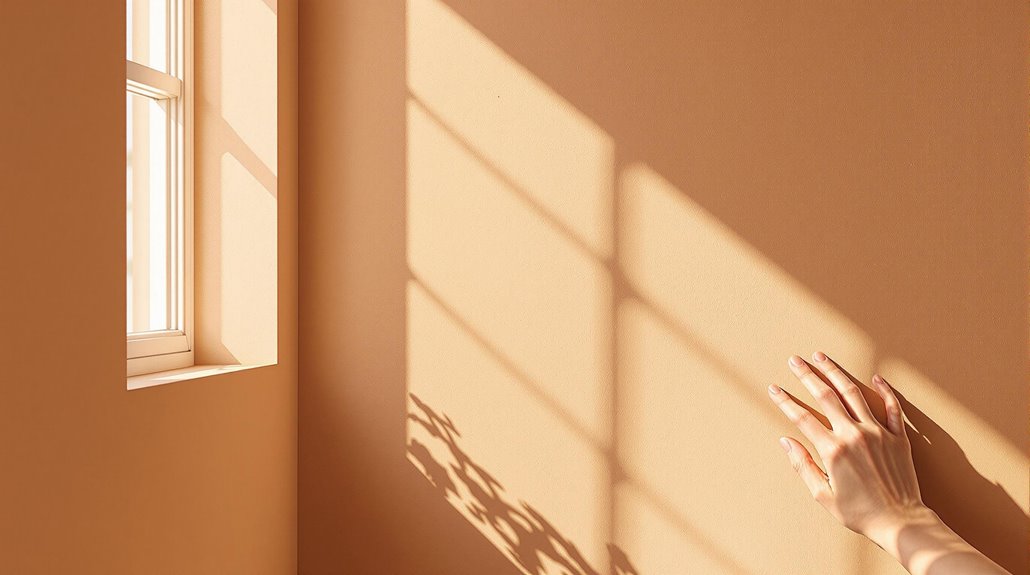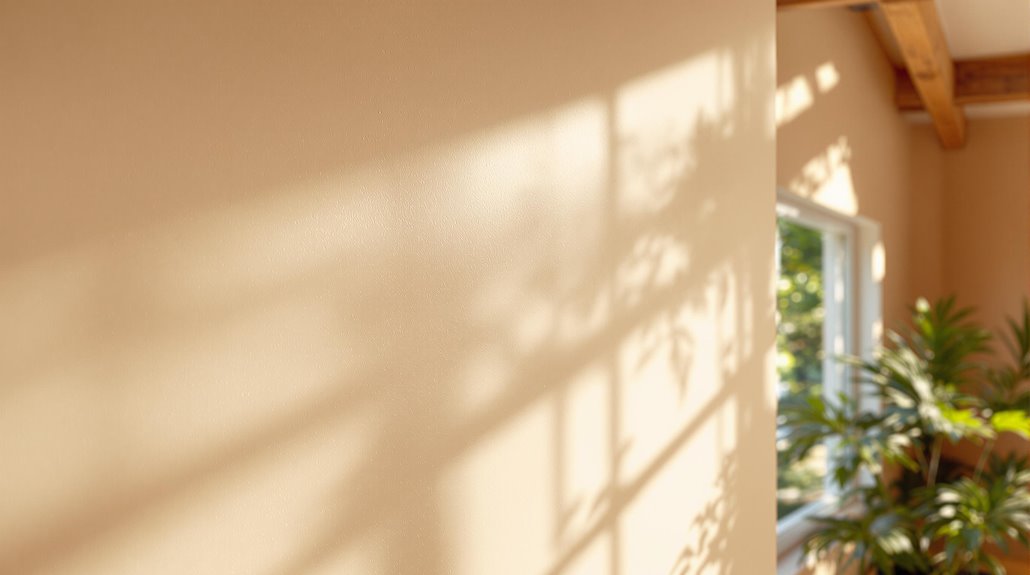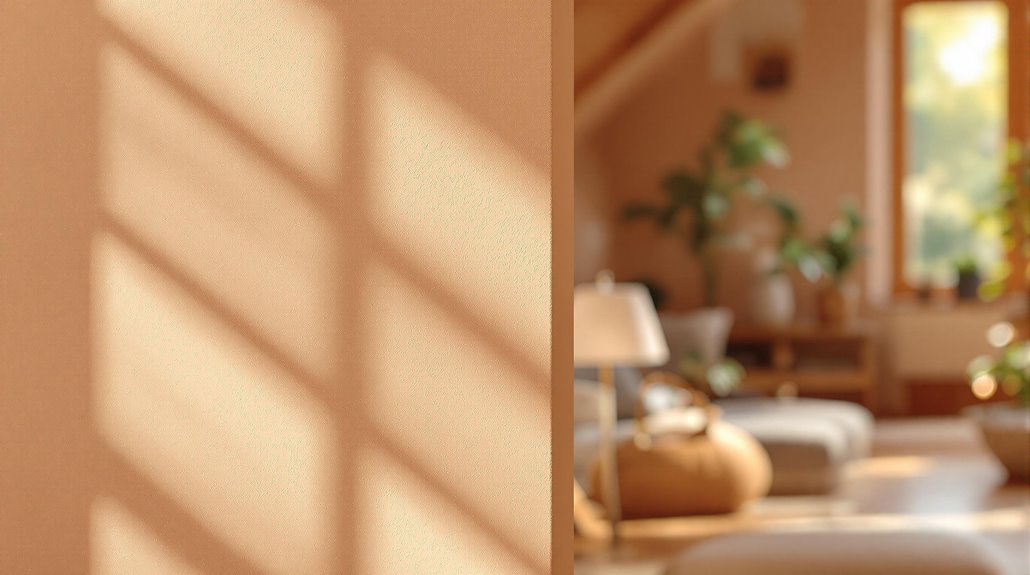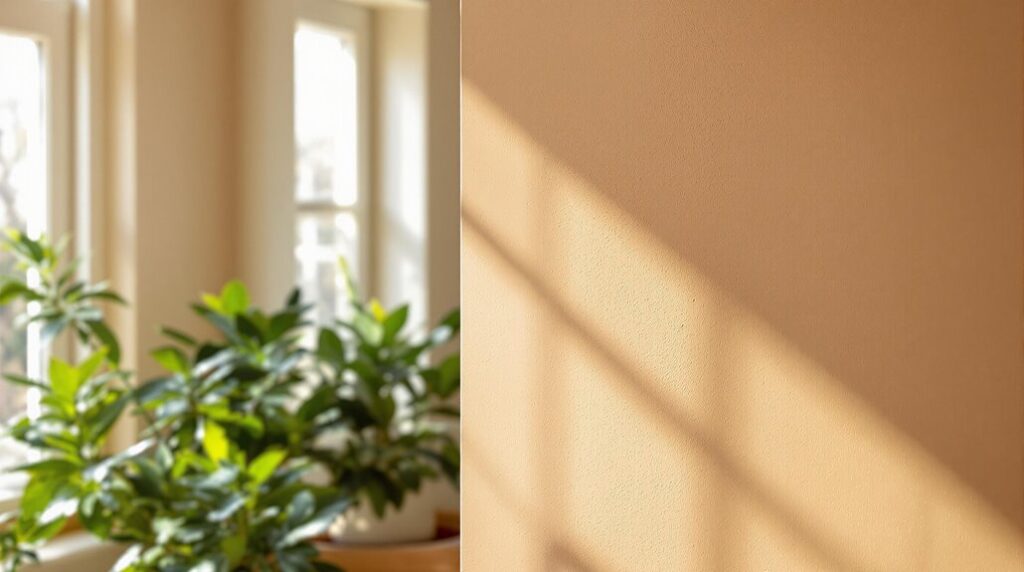I’ve been working with clay plaster for years, and I can tell you it’s transformed how I approach interior finishes. You’re probably dealing with poor air quality, high energy bills, or simply want to move away from chemical-laden wall treatments. Clay plaster solves these problems while delivering stunning visual results. What I’ve discovered about its unique properties and practical application methods will change how you think about your next renovation project.
Key Takeaways
- Clay plaster produces 0.0484 kgCO₂e/kg and emits 90% less CO₂ than gypsum-based finishes with carbon-negative manufacturing.
- Made from natural sand, clay, silt, and water without industrial binders, petrochemical derivatives, or chemical stabilizers.
- Acts as air purification system, reducing formaldehyde by 30% and absorbing ozone, VOCs, and airborne particles.
- Offers over 80 pre-mixed colors with integral coloration, eliminating paint needs and enabling custom textures.
- Provides superior moisture regulation with five times greater absorption than gypsum plaster, preventing mold growth naturally.
Pure Natural Composition Without Toxic Chemicals

While conventional plasters burden your indoor air with formaldehyde, VOCs, and synthetic chemicals, clay plaster delivers a stimulatingly pure alternative that’s built from the ground up—literally. I’m talking about a composition that’s invigoratingly straightforward: sand, clay, silt, and water. That’s it.
You won’t find any industrial binders, petrochemical derivatives, or chemical stabilizers here. Instead, I rely on clay’s natural adhesion properties and pH-neutral mineral balance to create walls that breathe naturally. When I need extra cohesion, I’ll add wheat paste or cellulose fibers like cattail fluff. Fresh cow manure serves as my go-to organic stabilizer.
This approach eliminates the toxic off-gassing that plagues synthetic alternatives, giving you genuinely clean indoor air that supports your family’s health. Beyond chemical purity, clay plaster naturally regulates moisture in your space, absorbing excess humidity during summer months to maintain comfortable air conditions.
Indoor Air Quality and Respiratory Health Benefits
This clean composition transforms into a powerful air purification system that actively improves your respiratory health. I’ve discovered clay plaster doesn’t just sit passively on your walls—it’s working around the clock to neutralize harmful pollutants. It strips formaldehyde from your air by up to 30%, tackles ozone that irritates your lungs, and absorbs VOCs from carpets and furniture. You’ll breathe easier knowing it captures dust and pollen through natural electrostatic properties.
The humidity regulation feature keeps your home at that sweet spot of 40-60%, preventing mold growth and dust mites that trigger asthma. These clay-based coatings demonstrate remarkable effectiveness at removing ozone from your indoor environment, as research by Corsi and Darling has shown. Since clay plaster emits zero VOCs itself, you’re eliminating chemical off-gassing while creating an environment where allergens can’t accumulate on dust-repellent surfaces.
Sustainable Materials With Minimal Carbon Footprint

Beyond improving your indoor air quality, clay plaster delivers extraordinary environmental benefits that’ll transform how you think about sustainable building materials. I’ve found clay plaster produces just 0.0484 kgCO₂e/kg compared to paint’s staggering 28× higher emissions. You’re choosing a material that emits 90% less CO₂ than gypsum-based finishes while outperforming lime and cement plasters considerably.
What makes clay plaster truly remarkable is its carbon-negative manufacturing process. The unbleached paper packaging actually sequesters more carbon than production emits. When your project’s complete, you’ll have a fully recyclable, compostable finish that returns to natural cycles without synthetic additives or VOCs. Clay plaster promotes healthy living environments by naturally regulating humidity and eliminating harmful chemical emissions from your walls.
Since transportation accounts for 90% of emissions, choosing locally-produced UK clay plaster dramatically reduces your project’s carbon footprint while supporting domestic manufacturing.
Unlimited Design Possibilities and Visual Appeal
Creative expression becomes limitless when you discover clay plaster’s remarkable design versatility. I’ve seen over 80 pre-mixed colors transform spaces from earthy neutrals to bold statement walls. You’ll eliminate paint entirely since integral coloration runs throughout the material.
Custom aggregates like mica create stunning reflective surfaces, while specialized trowel techniques produce anything from smooth minimalist finishes to rustic textures. I particularly love how you can replicate stone or concrete appearances without sacrificing sustainability.
The real magic happens with decorative techniques—stenciling, sgraffito, and relief sculpting turn walls into artistic canvases. Variable application thickness creates dimensional depth, and burnishing techniques add subtle sheens. Custom samples can be created to perfectly match your unique design vision, ensuring every project reflects your specific aesthetic goals. Whether you’re working curved surfaces or complex geometries, clay plaster adapts seamlessly to your creative vision.
Thermal Performance and Functional Properties

While clay plaster won’t match dedicated insulation materials, its thermal conductivity of 0.84 W/mk delivers meaningful performance benefits that I’ve observed in countless projects. You’ll find it works brilliantly as an adhesive coat beneath wood fibre insulation, buffering condensation and keeping your insulation drier.
What truly sets clay plaster apart is its hygroscopic nature – it actively regulates humidity between 40-70%, protecting timber from microbial damage. I’ve seen this breathability minimize mould growth without material degradation. You can enhance thermal performance by adding cork granules, perlite, or straw, though you’ll need to experiment with ratios.
The key is leaving it unpainted to preserve those humidity-regulating properties that make your home healthier and more comfortable. The reversible nature of clay plasters makes repairs and renovations straightforward, supporting both conservation projects and modern sustainable building approaches.
Moisture Management and Fire Safety Features
Clay plaster’s moisture management capabilities go far beyond simple humidity regulation – they create a sophisticated defense system for your building’s structural integrity. I’ve seen how this natural material maintains that critical 40-60% humidity zone through its hygroscopic properties, actively absorbing excess moisture when humidity spikes and releasing it when conditions dry out.
You’ll notice the difference immediately – five times greater moisture absorption than standard gypsum plaster means your walls become active participants in climate control. The capillary action draws dampness from the air before it can condense on surfaces, preventing mold growth and protecting your timber framework from rot and insect damage. This vapor-permeable system works silently, creating imperceptible air changes that stabilize your indoor environment naturally.
Beyond moisture control, clay plaster offers significant advantages for individuals with respiratory conditions, as it reduces airborne particles that can trigger breathing difficulties and allergic reactions.
Application Guidelines and Practical Considerations

Before you can achieve that smooth, natural finish clay plaster promises, you’ll need the right foundation and tools working in your favor. I’ll help you master the essentials that separate successful applications from frustrating failures.
Start with properly primed, clean surfaces—dust and debris are your enemies here. You’ll want a hawk, steel laying-on trowel, and plastic smoothing tools in your arsenal. Mix only what you’ll use daily, adding water incrementally to maintain workability.
Apply two passes: first at 1mm for coverage, second for your final 2-3mm thickness. Never exceed 3mm total—trust me on this. Work in 1m² sections, maintaining wet edges to avoid visible seams. For the best results, consider working with approved applicators who have received specialized training in natural plaster techniques. Clean tools immediately afterward, and you’ll thank yourself later when everything works smoothly.
Conclusion
I’ve shown you how clay plaster tackles your biggest wall finishing challenges – eliminating toxic fumes, improving air quality, and reducing environmental impact. You’ll get superior moisture control, fire resistance, and thermal performance while choosing from 80+ colors. Don’t let outdated synthetic finishes compromise your family’s health or your sustainability goals. Make the switch to clay plaster and transform your walls into functional, beautiful surfaces that actually benefit your home’s environment.
References
- https://clay-works.com
- https://www.evokepolishedplastering.co.uk/clay-duro-antique-provence-plastering/
- https://www.homebuilding.co.uk/advice/clay-plaster
- https://lunaplaster.co.uk/clay-plaster/
- https://armourcoat.com/en-us/products/clay-lime-plaster/
- https://theyearofmud.com/2009/06/17/clay-plaster-finish-recipe/
- http://buildnaturally.blogspot.com/2012/08/finish-clay-plaster-recipe-wall.html
- https://www.americanclay.com/faqs
- https://theyearofmud.com/2017/01/06/base-coat-clay-plaster/
- https://www.festool.com/blog/know-how/clay-and-lime-plaster

